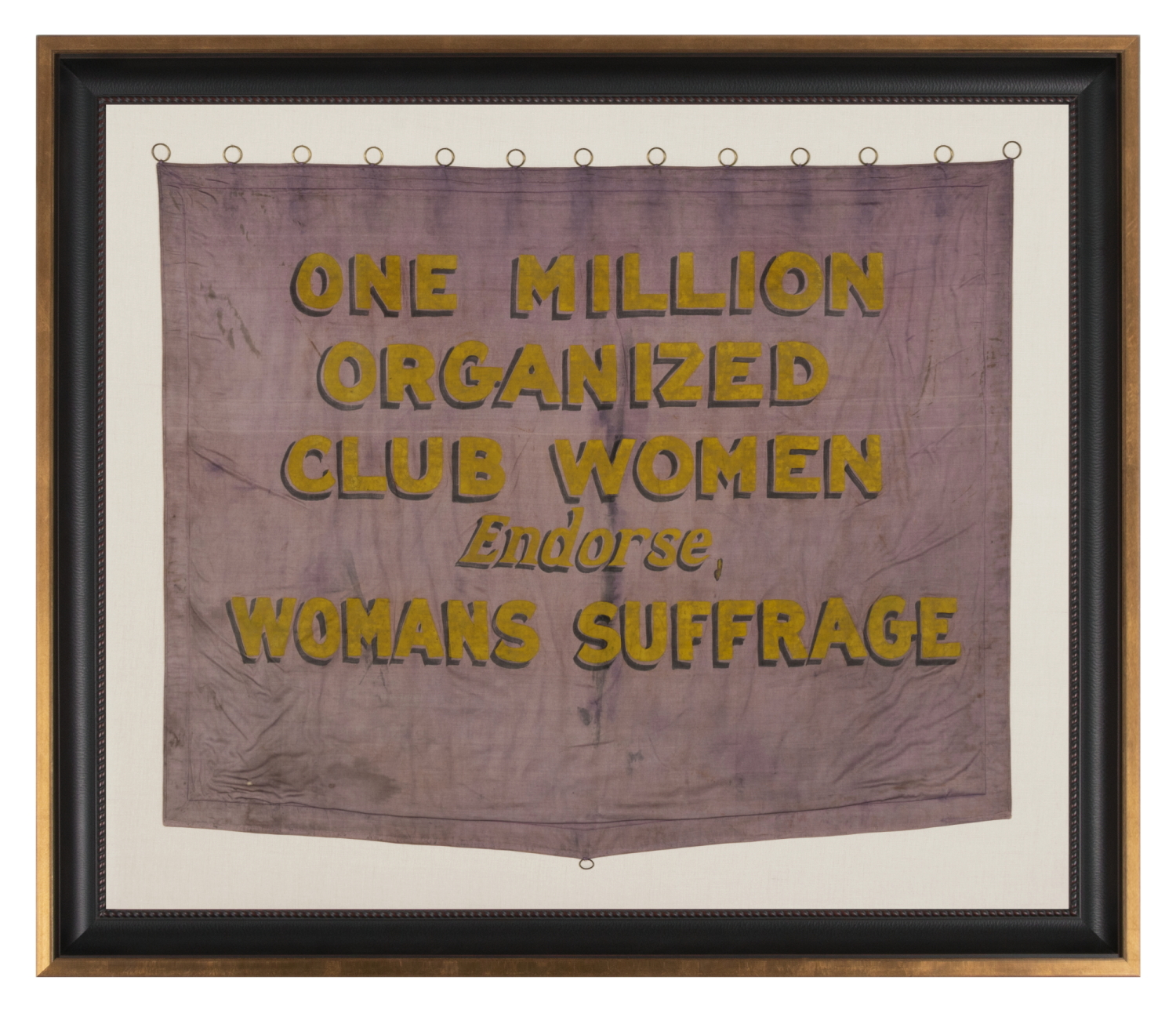
| |
RARE VIOLET & YELLOW SUFFRAGETTE PARADE BANNER WITH PAINTED TEXT THAT READS: “ONE MILLION ORGANIZED CLUB WOMEN ENDORSE, WOMANS SUFFRAGE.” MADE circa 1910-1920, THIS IS THE PLATE EXAMPLE FROM THE BEST PICTORIAL REFERENCE ON SUFFRAGE COLLECTING |
|
| Available: |
Sold |
| Frame Size (H x L): |
Approx. 45" x 52.5" |
| Flag Size (H x L): |
33.5" x 41" (plus rings) |
|
| Description....: |
|
Hand-painted banners of this general size and style were carried by Suffragettes in parades and rallies throughout America. While many bearing the names of Suffrage organizations, with or without all manner of wonderful slogans and messages employed by the movement, scarcely any of these have survived to the present day. Of those known, some display the names of states that had previously adopted suffrage, as a means of validating why others should follow. Some displayed the names of civic groups that supported the cause, yet have no text about the movement specifically. Others feature slogans that a modern audience would be hard-pressed to tie to Suffrage.
Made of violet satin, bound about the perimeter by early machine stitching, this particular banner displays the following verbiage in shaded, gold letters:
“One Million Organized Club Women Endorse, Womans Suffrage”.
Horizontal in format, with a slightly wedged profile along the lower edge, this style of textile was made to be draped vertically, by way of an upright, T-shaped staff. 13 small brass rings were hand-stitched at regular intervals along the top, to suspend it, with a single 14th ring in the bottom center, to aid with keeping it in place.
This exact banner is documented in "The Keynoter: Journal of the American Political Items Conservators," Summer/Fall/Winter 2008 (Women's Suffrage Special Triple Issue), Volume 2008, Number 2-4), p.96. This issue was entirely dedicated to Suffrage collecting and serves as the best pictorial reference in the hobby.
Golden yellow was the customary color of the suffrage movement in America, a tradition begun with the first actual campaign to give women the right to vote. This took place in 1867 in Kansas, the first state to hold a referendum on the issue, when suffragists Susan B. Anthony and Carrie Stanton focused their efforts there and wore sunflowers—the state flower—in a show of support, as well as yellow ribbons. The flower was an appropriate emblem for a rising sun and growth, which led to its use in other states. The color would carry through over to many other objects employed in the campaign for years to come. In England, green, white, and purple / violet were introduced in 1908 and became the colors of the movement, which gave way to a nice acronym for “Give Women the Vote.” This particular banner combines both the U.S. and English colors.
It is of interest to note that when large groups of hand-painted banners appeared at a single march, the four above colors were often mixed and matched, sometimes with others, namely blue, often used to denote Carrie Chapman Catt’s Empire State Campaign Committee (New York), or simply red, white, and blue, as a display of American patriotism.
All-in-all, a fantastic, rare, and interesting banner for any collection, with important documentation in the leading reference.
Mounting: For 25 years we have maintained our own textile conservation department, led by a master’s degree level graduate from one of the nation’s top programs. We take great care in the mounting and preservation of flags and related textiles and have preserved thousands of examples.
The pennant was mounted and framed by us, in-house. It has been hand-stitched to 100% hemp fabric, ivory in color, with a twill weave. The mount was placed in a deep, cove-shaped molding with a rope-style inner lip and a dark brown surface, nearly black, with reddish undertones and highlights. To this a deep, gold, shadowbox molding with a rectangular profile was added as a cap. The glazing is U.V. protective acrylic (Plexiglas).
Condition: There is moderate fading of the purple fabric. There is minor to moderate staining in various areas, the most significant of which is a vertical stain that extends along the center for approximately 2/3 of the distance. The lower edge of the banner was once trimmed in gold, woolen fringe. Part of this was absent and the remainder was removed. There is a tiny hole in the bottom left corner. |
|
|
|
| Collector Level: |
Flags for the truest Patriots. My best offerings |
|
| Flag Type: |
Sewn flag |
|
| Star Count: |
|
|
| Earliest Date of Origin: |
1910 |
|
| Latest Date of Origin: |
1920 |
|
| State/Affiliation: |
|
|
| War Association: |
|
|
| Price: |
SOLD |
|
| |
Views: 149 |
|
|
|

